 Last additions - NIIGATA 新潟県 Last additions - NIIGATA 新潟県 |

Entrance to the Yoshida Togo Memorial Museum which exhibits various documents and personal effects of Yoshida Togo. Museum admission 300 yen. Closed Mon.Dec 03, 2007
|
|

Inside Yoshida Togo Memorial Museum. The 2nd floor also has a display panel about his son Yoshida Chiaki who composed the song "Hitsuji-gusa" whose melody was used in the song "Biwako Shuko no Uta" (Lake Biwa Rowing Song).Dec 03, 2007
|
|

A room in the birth home of Yoshida TogoDec 03, 2007
|
|

Garden of the birth home of Yoshida TogoDec 03, 2007
|
|

Rear view of birth home of Yoshida Togo who was a famous geographer of Japan who compiled an encylopedia of Japanese place names. His son was Yoshida Chiaki who composed the melody of the song "Biwako Shuko no Uta" (Lake Biwa Rowing Song).Dec 03, 2007
|
|

Former Hatano residence and birth home of Yoshida Togo 旧旗野邸 (吉田東伍生家)Dec 03, 2007
|
|

Tourist info booth sells duck feedDec 03, 2007
|
|

Map of lake areaDec 03, 2007
|
|

Pedestrian overpass with swan motif.Dec 03, 2007
|
|

Dec 03, 2007
|
|

Quack, quack. Actually the ducks were pretty quiet.Dec 03, 2007
|
|

Dec 03, 2007
|
|

They all face the same direction. Group oriented.Dec 03, 2007
|
|

SwanDec 03, 2007
|
|

Whooping swans mix with the ducks.Dec 03, 2007
|
|

Dec 03, 2007
|
|

Dec 03, 2007
|
|

In Oct. 2008, Lake Hyoko was added to the list of wetlands of international importance under the Ramsar Convention on Wetlands.Dec 03, 2007
|
|

Dec 03, 2007
|
|

Thousands of ducksDec 03, 2007
|
|

Dec 03, 2007
|
|

Duck feedingDec 03, 2007
|
|

Lake Hyoko (Lake Hyo), a man-made lake where thousands of swans and ducks migrate to during the winter months.Dec 03, 2007
|
|
|
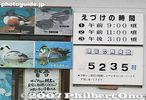
Duck species in the lake and the number of birds so far.Dec 03, 2007
|
|

Dec 03, 2007
|
|

SalmonDec 03, 2007
|
|

CrabDec 03, 2007
|
|

Sakana-no-Furusato Bandaijima Fish market near Toki Messe. さかなのふるさと万代島Dec 03, 2007
|
|

Bandai-bashi Bridge. The tall building is Toki Messe.Dec 03, 2007
|
|

CrabDec 03, 2007
|
|

On Bandai-bashi BridgeDec 03, 2007
|
|

JR Niigata Station 新潟駅Dec 03, 2007
|
|

Niigata StationDec 03, 2007
|
|

Road in front of Niigata StationDec 03, 2007
|
|

Dec 03, 2007
|
|

Inside the Shukokan rice warehouse, now an antique exhibition room. 集古館Dec 03, 2007
|
|

Museum officeDec 03, 2007
|
|

Rear drawing room (Urazashiki) adjacent to the Ohiroma main drawing room.Dec 03, 2007
|
|

Built in 1891, Sanraku-tei, a highly unusual triangular tea house. 三楽亭Dec 03, 2007
|
|
|
|

Dec 03, 2007
|
|

Corner of rear drawing room (urazashiki)Dec 03, 2007
|
|

The rear drawing room was where guests would wait until they were welcomed into the Ohiroma main drawing room.Dec 03, 2007
|
|

With 100 tatami mats, the Ohiroma drawing room is the most impressive room in the house.Dec 03, 2007
|
|

Inside Sanraku-tei with unusually shaped tatami mats to fit the triangular floor. It has three rooms, one was a study and another was a tea ceremony room.Dec 03, 2007
|
|

Dec 03, 2007
|
|

Impressive garden views from the rear drawing room (urazashiki)Dec 03, 2007
|
|

Courtyard gardenDec 03, 2007
|
|

Garden facing the drawing rooms. 庭園Dec 03, 2007
|
|

Ohiroma drawing room and adjacent garden in autumn.Dec 03, 2007
|
|

Courtyard garden 中庭Dec 03, 2007
|
|

Veranda of Ohiroma drawing roomDec 03, 2007
|
|

Veranda along the courtyard gardenDec 03, 2007
|
|

Ohiroma drawing room was used only a few times a year for wedding and funeral receptions, etc.Dec 03, 2007
|
|

Ohiroma drawing roomDec 03, 2007
|
|

CorridorDec 03, 2007
|
|

Lacquerware on displayDec 03, 2007
|
|

Room with a view: This is the centerpiece of the former home, a large drawing room (Ohiroma) used for large gatherings. It gives a marvelous view of the garden. 大広間Dec 03, 2007
|
|

Courtyard garden as seen from the 2nd floor.Dec 03, 2007
|
|

2nd floor exhibition room displays various artifacts of the Itoh family. The room formerly served as a storeroom and workroom for making futon and rags. 考古資料館Dec 03, 2007
|
|

VerandaDec 03, 2007
|
|

Dec 03, 2007
|
|

Hearth in the kitchen. A bale of rice (60 kg) was cooked every day. Over 50 maids, cooks, and other servants worked in the house.Dec 03, 2007
|
|

PlateDec 03, 2007
|
|

Corridor facing the courtyard.Dec 03, 2007
|
|

Irori hearth next to the kitchen. 囲炉裏Dec 03, 2007
|
|

Display of stuffed toki or crested ibis, an endangered species. Official bird of Niigata and raised on Sado island.Dec 03, 2007
|
|

Cha-no-ma living roomDec 03, 2007
|
|

The first room you see is this Cha-no-ma living room where the head of the household greeted guests. Built in 1885-1887, the house has more than 60 rooms, with a floor space of about 4,000 sq. meters. 茶の間Dec 03, 2007
|
|

It was Japan's first private museum to receive governmental approval. During the years following, it took several years to rebuild the garden and buildings. This is the museum office next to the entrance.Dec 03, 2007
|
|

Entrance foyer (unused). I had the pleasure of meeting Itoh Bunkichi VIII who explained about how the property was saved by Lt. Wright. He was the one who built the monument for his father and Lt. Wright.Dec 03, 2007
|
|

When Wright found out that Bunkichi was a fellow University of Pennsylvania graduate, he fully supported the preservation of the property. They saved the property by converting it into a museum. A foundation was established and the property was donated to it. Pictured is Ralph Wright and Itoh Bunkichi VIII (1927- ), the son of Bunkichi VII (1896-1958).Dec 03, 2007
|
|

Acting on reports that the Itoh property was storing hidden materials for the old Imperial Army, Lt. Ralph E. Wright from the American Occupation forces conducted a search and met Itoh Bunkichi VII, the owner. Photo: Grave of Ralph E. Wright-Peterson.Dec 03, 2007
|
|

The museum is within a spacious, garden-like grounds. It includes the main house, tea houses, storehouse, and a few shops and restaurants.Dec 03, 2007
|
|

Monument for Itoh Bunkichi VII (1896-1958) and Lt. Ralph E. Wright (from Peoria, Illinois). Right after WWII in 1945, they saved the property from being demolished due to the Land Reform Act.Dec 03, 2007
|
|

Entrance to Northern Culture Museum, formerly the Japanese-style mansion of the Ito farming family who were a wealthy landowner from the 18th century.Dec 03, 2007
|
|

Dec 03, 2007
|
|

Fishing boatsDec 03, 2007
|
|

Central NiigataDec 03, 2007
|
|

Dec 03, 2007
|
|

Dec 03, 2007
|
|

Dec 03, 2007
|
|

Dec 03, 2007
|
|

Ferry to Sado island.Dec 03, 2007
|
|

Toward the mouth of Shinano River.Dec 03, 2007
|
|

Dec 03, 2007
|
|

Too hazy to see Sado island.Dec 03, 2007
|
|

Dec 03, 2007
|
|

In the foreground is Bandaibashi Bridge, spanning Shinano River.Dec 03, 2007
|
|

Toki Messe's tower is the city's tallest building at 140 meters.Dec 03, 2007
|
|

The observation deck is about 125 meters above the ground. The tallest building along the Sea of Japan coast. Fine view of Shinano River.Dec 03, 2007
|
|

Toki Messe is a multipurpose complex which includes a convention center, exhibition hall, hotel and office tower (the city's tallest building), art museum, and an observation deck on the 31st floor.Dec 03, 2007
|
|

Across from the Omotemon Gate is a small park with a statue of Hirobe Yasubei who was from Shibata and one of the 47 ronin (masterless samurai) who avenged his master Lord Asano of Ako, dramatized in Chushingura.Dec 03, 2007
|
|

Entrance to upper floor of Omotemon GateDec 03, 2007
|
|

Shibata Castle Park mapDec 03, 2007
|
|

Statue of Horibe Yasubei (1670-1703). He looks toward Edo (Tokyo).Dec 03, 2007
|
|

Horibe Yasubei was also a master swordsman. 堀部安兵衛Dec 03, 2007
|
|

Inside Kyu-Ninomaru Sumi-yagura TurretDec 03, 2007
|
|

View from upper floor of Omotemon Gate 表門Dec 03, 2007
|
|

Inside upper floor of Omotemon Gate 表門Dec 03, 2007
|
|

Dec 03, 2007
|
|

Inside upper floor of Omotemon Gate 表門Dec 03, 2007
|
|

Dec 03, 2007
|
|

Ground Self-Defence Force base occupies half the castle site (since 1953). The reason why we cannot enter the Sangai Yagura Turret seen here within the base.Dec 03, 2007
|
|

Second floor of Kyu-Ninomaru Sumi-yagura TurretDec 03, 2007
|
|

Inside Kyu-Ninomaru Sumi-yagura TurretDec 03, 2007
|
|

Inside Kyu-Ninomaru Sumi-yagura TurretDec 03, 2007
|
|

Kyu-Ninomaru Sumi-yagura Turret 旧二の丸隅櫓Dec 03, 2007
|
|

Kyu-Ninomaru Sumi-yagura Turret 旧二の丸隅櫓Dec 03, 2007
|
|

Stone dropping slotDec 03, 2007
|
|

Kyu-Ninomaru Sumi-yagura Turret, one of two Edo-Era castle structures. 旧二の丸隅櫓Dec 03, 2007
|
|

Dec 03, 2007
|
|

Dec 03, 2007
|
|

Sangai Yagura TurretDec 03, 2007
|
|

Inside Tatsumi Yagura Turret 辰巳櫓Dec 03, 2007
|
|

Dec 03, 2007
|
|

Ceiling of Tatsumi Yagura TurretDec 03, 2007
|
|

Banner with the five-diamond clan crest. Sangai Yagura Turret in the distanceDec 03, 2007
|
|

Statue of Lord Mizoguchi Hidekatsu (1548-1610), the first lord of Shibata Castle. 溝口秀勝Dec 03, 2007
|
|

Tatsumi Yagura Turret. Traditional building methods were used to reconstruct the turret.Dec 03, 2007
|
|

Second floor of Tatsumi Yagura TurretDec 03, 2007
|
|

Second floor of Tatsumi Yagura TurretDec 03, 2007
|
|

Steps to Tatsumi Yagura Turret, reconstructed in June 2004. 辰巳櫓Dec 03, 2007
|
|

Omotemon Gate, one of two Edo-Era structures in Shibata Castle and an Important Cultural Property. 表門Dec 03, 2007
|
|

Inside Tatsumi Yagura Turret 辰巳櫓Dec 03, 2007
|
|

Tatsumi Yagura Turret 辰巳櫓Dec 03, 2007
|
|

Statue of Lord Mizoguchi Hidekatsu (1548-1610), the first lord of Shibata Castle. 溝口秀勝Dec 03, 2007
|
|

Stone wall with perfectly-fitting stones. No gaps between the stones.Dec 03, 2007
|
|

Kyu-Ninomaru Sumi-yagura Turret, an Important Cultural Property 旧二の丸隅櫓Dec 03, 2007
|
|

Tatsumi Yagura Turret, reconstructed in June 2004. 辰巳櫓Dec 03, 2007
|
|

Omotemon Gate 表門Dec 03, 2007
|
|

Kyu-Ninomaru Sumi-yagura Turret. Toward the base above the stone wall, notice the "namako-kabe" pattern wall 海鼠壁. It resists snow. 旧二の丸隅櫓Dec 03, 2007
|
|

Omotemon Gate, another Important Cultural PropertyDec 03, 2007
|
|
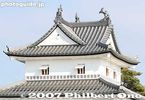
Sangai Yagura Turret with three shachi sculptures on the T-shaped roof. Unique to Shibata Castle. Unfortunately, we cannot enter this turret since it is within the Ground Self-Defence Force base which occupies much of the castle grounds.Dec 03, 2007
|
|

Due to the Meiji government's castle destruction order, most of the castle moats were filled in except for this one next to the Honmaru. After World War II, US troops occupied the castle grounds for a short time..Dec 03, 2007
|
|

Kyu-Ninomaru Sumi-yagura Turret, one of the two surviving Edo-Era structures. The castle originally had 11 turrets and 5 gates (no castle tower). The Meiji government ordered its destruction in 1872. All the structures were dismantled except two.Dec 03, 2007
|
|

Moat leading to Kyu-Ninomaru Sumi-yagura TurretDec 03, 2007
|
|

Sangai Yagura Turret, Shibata Castle 三階櫓, Niigata. The castle never had a tenshukaku castle tower (donjon), so this turret was the grandest castle structure.Dec 03, 2007
|
|

Shibata Castle, Niigata (Sangai Yagura Turret)Dec 03, 2007
|
|

Sangai Yagura Turret, Shibata Castle 三階櫓Dec 03, 2007
|
|

Sangai Yagura Turret, Shibata Castle 三階櫓Dec 03, 2007
|
|

Sangai Yagura Turret, Shibata Castle. Reconstructed in June 2004 with traditional building methods taking 2 years. 三階櫓Dec 03, 2007
|
|

Completed around 1654, Shibata Castle is the only castle in Niigata with Edo-Era structures still remaining. Two turrets were reconstructed in June 2004. The castle grounds is also occupied by the Ground Self-Defence Forces, making the area open to the public quite small. One of the reconstructed turrets is also inaccessible due to the military base. Still, it is one of Japan's 100 Famous Castles. Entrance to Shibata Castle.Dec 03, 2007
|
|

Shibata Castle is the only castle in Niigata with Edo-era structures still standing.Dec 03, 2007
|
|

Shibata Castle is also called Ayame Castle 菖蒲城.Dec 03, 2007
|
|
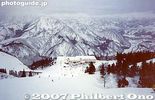
View from the top.Apr 02, 2007
|
|
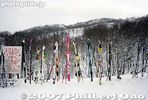
Skis left outside as their owners have lunch. It's nice that no one steals your skis.Apr 02, 2007
|
|
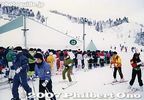
The line gets very long during the morning, so I usually go later in the day and ski until night when it is much less crowded. I catch the last shinkansen back to Tokyo.Apr 02, 2007
|
|

From Tokyo, Gala Yuzawa is the most convenient place to ski. The Joetsu shinkansen can take you there in little over an hour and the train station has the ski gondola. An easy day trip.Apr 02, 2007
|
|

It's not a large or long run, but better than nothing.Apr 02, 2007
|
|

The quality of the snow is not as good as in Hokkaido, but better than nothing.Apr 02, 2007
|
|
|
|